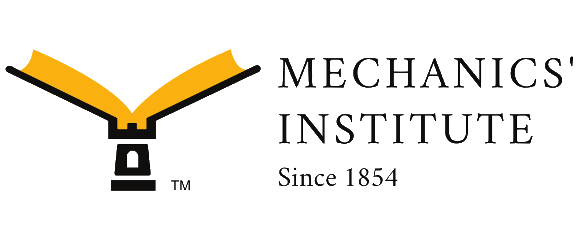
Until recently, an image of John Sime, a former Mechanics' Institute's (MI) Board of Trustee President has eluded me. For several years, I have been corresponding with John Sime's biographer, Barry Brown, hoping to find a photograph of one of MI's earliest founders, who served as Board President from 1857-58. Since Brown is known as an expert on one of Mr. Sime’s endeavors "the California Powder Works." I hoped he might provide helpful information.
What I learned was that separately, but on parallel research journeys, Brown and I had both scoured local archives for a picture of John Sime to no avail. Finally, about three years ago Brown found Mr. Sime in the DeYoung museum’s collection -- a portrait enlarged from a photograph that had been donated by Mr. Sime’s son. In September, 2020, during the thick of the pandemic, Brown wrote to tell me that the DeYoung Museum was looking for a new guardian for this portrait.
After several emails with the Fine Arts Museums of San Francisco, the portrait was made a gift to MI. To my delight, Mr. Sime’s visage has returned to the community he helped conceive and build. He will reside in MI's Archives until we can reopen safely and determine an appropriate means to display his portrait.
Why was John Sime important to MI?
Imagine, if you will, a late afternoon on Thursday May 21, 1857, when three men stepped through the threshold of the former Metropolitan Market on Market at Second Street. The men -- William McKibben, Henry Fairfax Williams, and John Sime -- were all members of the Mechanics’ Institute’s (MI) Board of Trustees and formed the committee tasked with finding an appropriate venue for MI’s first industrial exhibition slated to take place that September.
The Market was one of three locations under consideration. Opened in late 1854, it had thrived as an emporium with 53 stalls selling “meats, poultry, game, fish, vegetables, and fruits."The Market's brilliant gas lighting and convenient hours made it a favorite with restaurateurs and hoteliers, as well as residential households. For reasons unknown, the Market had recently been sold, and the space was rebranded as a Horse Market and Sale Stable.
“The stalls will have to come out,” Mr.Sime, then President of the Mechanics’ Institute, commented to his companions as they walked through the building, manure sticking to their boots. The proprietor, only lukewarm about renting the space at all, followed close at heel and was quick to add indignantly “those stalls will have to be replaced once the affair is over."
While the gas lighting was a plus, the stench of horses, large rental fee, and additional costs associated with making the space suitable were significant drawbacks as far as the committee was concerned. Mr. Lick’s attorney, Hall McAllister had alluded that the lot could be let cheaply once the circus had packed up. Mr. Williams was certain they could get a better price at one of the other venues.
The fledgling MI, in operation for a little more than two years, had suffered financial setbacks since the murder of outspoken journalist James King of William in May of 1856. The resulting civil unrest - hundreds of armed men walking the streets, public hangings, and secret trials - had put a damper on residents' enthusiasm for city living. This resulted in MI experiencing financial issues. Getting members to pay their quarterly dues and for the stock they had purchased was a challenge. (in MI's early days, it operated as a joint stock company, and dues were levied quarterly.) MI's Board of Trustees was hopeful that the upcoming industrial exhibition would not only jumpstart the city’s flagging economy by highlighting San Francisco’s home-grown industry, but also serve as a fundraiser for MI’s continued operation.
The three men left the Market without closing the deal and met a few weeks later on the evening of June 5 for the monthly meeting of the Board of Trustees. During this meeting, Mr. Sime expounded passionately about the upcoming fair, “I fear that through the lukewarmness and indifference of our members the fair will fail…which would be ruinous to the Institute and disgraceful to the membership!” He urged his fellow trustees to take “energetic action” because the fair was “essential to the future prosperity of the Institute.”
As it turns out, Mr. Sime’s wishes came true. The lot at Post and Montgomery (where the Crocker Galleria and former Wells Fargo now reside) was rented for $1 a month from James Lick and a magnificent, 18,000-square foot building was framed by mid-July. The Mechanics’ Institute’s first industrial exhibition opened on September 7, and it was a resounding success. Its profits allowed MI to fund its lecture series, buy materials for its library, and make a sizable donation to the city’s two orphanages. Under Mr. Sime's leadership and encouragement, all of the labor for this endeavor was done by MI’s Board of Trustees and MI members.
Ultimately MI would host 31 industrial exhibitions between the years of 1857 and1899. These fairs were successful as a fundraising vehicle for MI and, perhaps more importantly, were critical to the development of industry in California. Many products and technologies that we know and love today debuted at these fairs, thanks in large part to MI President John Sime's energetic leadership.
A Bit More About John Sime
This little vignette is one of the few in the historical record that provides clues to John Sime’s personality. One of MI’s founders, Mr.Sime served as MI's President in 1857 and 1858. He was described by one source as being “five feet ten inches tall, stout, and of a very powerful frame who purportedly, in his younger years, could hold a smaller man off the floor with one arm." Mr. Sime indeed seems to have been a force to be reckoned with – his actions recorded in MI’s board minutes and in the private papers of his contemporaries, show that he was pugnacious and firm in his convictions.
Born about 1816 in either New Brunswick or New York (the historical record is unclear), Mr. Sime labored in his youth as a ship carpenter and a brick mason. He was employed in a Chilean flour mill when news of California’s gold reached him. Shortly thereafter he found himself in San Francisco. In the mid-1850s, he served briefly as a California Assemblyman and was a formidable advocate for the rights of the working class. His political record includes a bill that would allow mechanics to put a lien on property owned by people who had not paid for the contracted labor and publicly disputing the special license laws that unfairly targeted the artisans, craftsmen, and laborers of the City and County of San Francisco.
Sometime in 1856 or 1857, Mr. Sime opened a bank which became engaged in the speculation of mining stocks, particularly those related to the silver of the Comstock Lode. This endeavor ultimately led to the bank’s destruction, and, reportedly, contributed to Mr. Sime’s untimely death in 1871 -- as it was said, his body and constitution were broken. To his credit, Mr. Sime purportedly “lived to pay his every obligation," with interest as well. He also was involved with the California Powder Works – the “first and most influential explosives manufacturer in the Western United States."
Sources include:
Daily Placer Times and Transcript, December 11, 1854.
San Francisco Bulletin, June 3, 1857.
Minutes of the Mechanics’ Institute Board of Trustees, June 5, 1857.
Henry F. Williams’ Diary, Box 3, Bancroft Library.
Minutes of the Mechanics’ Institute Board of Trustees, June 5, 1857.
Schuck, Oscar, History of the bench and bar of California, 1901.
Armstrong, Le Roy, Financial California: an historical review of the beginnings and progress of banking in the state, 1916.
Brown, Barry, California Powder Works Minute Books, introduction.



